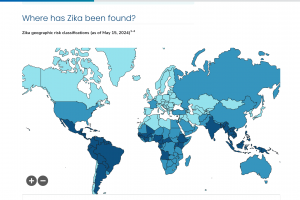Zika Outbreaks
Zika Outbreaks March 2025
Zika virus disease (ZIKV) was first recognized in Uganda in 1947. According to the World Health Organization (WHO), outbreaks have been noted in the Americas since 2007 and continue in 92 countries and territories globally. As of March 25, 2025, the WHO, the United States, the United Kingdom, and Canada list countries that account for about 95% of Zika cases between 2014 and 2024. In 2016, the WHO declared the Zika virus epidemic a public health emergency of international concern. The WHO published a Global Strategic Preparedness, Readiness, and Response Plan for Aedes-borne arboviruses on January 20, 2025. Studies predict that 1.3 billion people could be impacted by Zika by 2050.
In 2025, international travelers with suspected DENV infection should be tested at commercial labs with RT-PCR or an NS1 antigen test.
Zika Outbreak Impact
An Original Investigation published by JAMA Public Health on January 23, 2025, found that children younger than 5 years born with congenital Zika syndrome (CZS) had a 13.10-fold higher hazard of death compared with those without CZS. The cause-specific mortality hazard ratios were 30.28 for respiratory, 28.26 for infectious and parasitic, and 57.11 for nervous system diseases. Research published by the Liverpool School of Tropical Medicine in Communications Biology on January 20, 2025, reported that the Zika virus hijacks the skin of its human host to send out chemical signals that lure more mosquitoes to infect and spread the disease further.
Zika in the United States
The PAHO reported (0) Zika cases in the United States in 2025. As of December 31, 2024, the U.S. CDC reported 19 non-congenital Zika cases among U.S. residents (1 imported case in Texas). In 2023, the CDC reported five non-congenital cases among U.S. residents and 27 in U.S. territories. The CDC says Zika-spreading mosquitoes are found throughout Puerto Rico, where the Department of Health says 16 cases were reported in 2024.
Zika Outbreaks in The Americas
The Pan American Health Organization (PAHO) has confirmed local transmission of the Zika virus in 52 countries and territories in the Americas since 2015. As of March 25, 2025, 3,070 Zika cases (2,556 in Brazil, 433 in Argentina, 31 in Bolivia) were reported in the Americas in 2025. The PAHO has reported over 42,127 ZIka cases and two related fatalities in the Americas in 2024, with the highest proportion of Zika cases reported in Argentina, Brazil, Bolivia, Colombia, and Costa Rica. The PAHO reported over 37,659 Zika cases in the Americas in 2023.
Canada's level 2 travel health notice, updated in March 2025, states that most Zika virus infections in Argentina have been reported in the Northwest and Northeast regions of the country. In 2021, the U.S. CDC removed its Level 2—Practice Enhanced Precautions notice regarding Argentina's Zika outbreak.
Zika in Asia
Since 2016, the Zika virus has been reported in India's 16 different states/union territories. In December 2024, there were 148 AES cases, including 59 deaths 2024. Those infected also included 63 pregnant women. India reported 151 cases in Maharashtra, Kerala, Chickballapur, and Karnataka. In 2024, the U.K. stated travelers should practice usual precautions when visiting India's Zika outbreak areas, such as Maharashtra and Madhya Pradesh. In August 2024, the U.S. CDC issued a Level 2 - Practice Enhanced Precautions regarding an ongoing Zika outbreak in Maharashtra.
The Kingdom of Cambodia's Ministry of Health confirmed its first case of the Zika virus since 2016. Thailand reported 742 Zika virus infections in 2023,160, of which none were recorded in Bangkok. This is a significant increase from the 190 cases reported in 2022. Singapore reported 30 cases of Zika in 2023. The female Aedes aegypti mosquito is Singapore's primary vector of Zika.
Zika in Europe
The European Centre for Disease Prevention and Control (ECDC) says the Zika virus is not endemic in mainland Europe. In November 2024, Italy reported 7 imported Zika cases this year. On September 11, 2024, France reported five imported cases of Zika in 3 departments colonized by Aedes albopictus. In 2022, the European CDC reported that 31,453 Zika patients were confirmed in 13 of 52 countries and territories. In addition, the WHO reported in 2019 that French authorities confirmed an autochthonous Zika virus case in Hyeres, Var department.
Zika Pacific Islands
As of May 2024, anti-ZIKV antibodies were found in 66% of the Cook Island test collective and 52% of the Vanuatu specimens. As of October 2023, the Solomon Islands reported 7 Zika cases.
Zika Thailand
Thailand has seen ongoing Zika transmission into 2024, with 148 confirmed cases reported as of December, following the high levels of transmission from 2023, when 777 cases were reported in Thailand.
Zika United Kingdom
As of December 2024, 7 Zika virus cases (5 in London) were reported in England and one in Wales between January and June 2024. This UKHSA data represents a 700% increase compared to the same period in 2023. Thailand (5 cases) and Singapore (2) were the most frequently reported travel countries. The U.K. Health Security Agency (UKHSA) issued a warning on March 21, 2024, concerning Zika outbreaks. Travel-related Zika cases in the U.K. peaked in 2016 with 725 cases.
Zika Virus and Dengue
A study published in Science Translational Medicine on May 29, 2024, found that primary ZIKV infection increased the risk of disease caused by DENV3 and DENV4 but not DENV1. This was also true for tertiary infections when individuals were previously infected with DENV and then ZIKV, but not when they were previously infected with ZIKV and then DENV.
Zika Virus Infections
According to the WHO, there is scientific consensus that the Zika virus is transmitted to people by mosquitoes of the genus Aedes. The WHO says two Zika virus lineages, the African lineage and the Asian lineage, have recently spread in the Pacific and the Region of the Americas. Zika infections can cause microcephaly, Guillain-Barré syndrome (GBS), and other central nervous system malformations. Although the Zika outbreak in southern Brazil has slowed in recent years, live births with microcephaly continue to be reported.
The U.S. Centers for Disease Control and Prevention (CDC) published Research, Volume 30, Number 2—February 2024: temporal phylogenetic analysis revealed limited within-host diversity among most ZIKV-persistent infected associated samples. The researchers detected unusual virus temporal diversity, uncovering the existence of divergent genomes within the same patient. During pregnancy, healthcare providers can monitor the fetus for signs of congenital Zika virus infection, says the CDC.
Congenital Zika Syndrome
A population-based study of mortality rates among children younger than 5 years old in Brazil published in JAMA Network Open in January 2025 shows that children with congenital Zika syndrome (CZS) had a 13-fold higher risk of death compared with those without CZS.
The 2015–2016 ZIKV outbreak in the Region of the Americas revealed the ability of ZIKV from the Asian lineage to cause birth defects, generically called CZS, caused severe birth defects of the brain and eyes, including severe microcephaly. A study published in Pediatrics in January 2025 concluded children exposed to ZIKV in utero, even without CZS, demonstrate a greater risk for neurodevelopmental delay in early childhood, with the timing of maternal infection being a significant predictive risk factor. The International Journal of Infectious Diseases published a study in 2025 showing children with CZS will have more frequent hospitalizations in early childhood. Scientists have reported that ZIKV RNA is detectable in the semen of infected men for months and is found in newborn children.
Zika Vaccines
As of February 2025, there are no approved Zika vaccines, but vaccine candidates are conducting clinical research.





